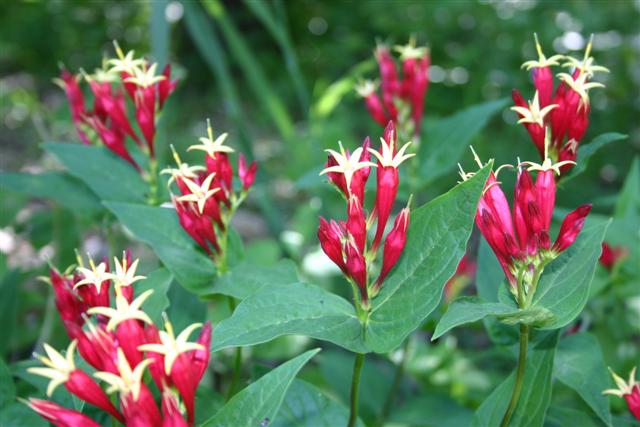Georgia Gardener Newsletter Cool Plant: May 29, 2008
| Indian Pink |
| Spigelia marilandica
|
Species Native Range: Central and SE U.S.
Hardiness: USDA Zones 5-9
Mature Size: 12-24 inches tall and wide
Exposure: Light to medium shade
Soil: Rich, moist but well-drained
Drought Tolerance: Very good to excellent
Ease of Culture: Easy
I'm often teased that my favorite native plant is the one that's currently blooming. That's partially true but when it
comes to Indian pink (which I call Spigelia), this plant is in my top five even in the dead of winter when it has disappeared
until spring. In May, the top of the plant is covered with bright red 1-inch tubular flowers that open with five-petals to reveal
a bright yellow throat. Sporadic flowers will appear through the summer.
It's hard to miss this bright color combination in a garden or in the woods. Hummingbirds love it.
Spigelia can be found scattered throughout Georgia in woodland areas that have rich, moist soil. In deep woods, the
plant may only have a few flowers. In partial shade, especially if it gets morning sun, the entire top of the plant will
be covered with flowers. The plant pictured above was found growing in deep shade in my woods with few flowers until I
moved it into a part-shade bed near the house.
Spigelia is very easy to grow in rich soil. I added an extra layer of mulch last year because of the drought and the clumps
almost doubled their size from the previous year without adding any fertilizer. Grow Spigelia in well-amended soil in a part shade bed or
woodland garden. Good companion plants include: hostas, hydrangeas, foam flower, native gingers, green n gold and ferns. An
especially attractive combination is to combine Spigelia with 'Lady in Red' lady fern where the red flowers of the Spigelia will
blend nicely with the red stem (rachis) of the fern.
Please note: Spigelia is eaten by both deer and rabbits. I've had a lot of success keeping the deer and rabbits away by
using repellents.
Sources
Although I have seen this plant for sale at these nurseries, I cannot guarantee that they will have it in stock
at the time of this publication.
Randy's Perennials: Lawrenceville
Plant Delights Nursery: mail order
Nearly Native Nursery: Fayetteville
You could also try the nurseries listed on the web site of the
Georgia Native Plant Society
Copyright © 2008 by Theresa Schrum - All rights reserved
No part of this website may be reproduced without the expressed written permission of Theresa Schrum

